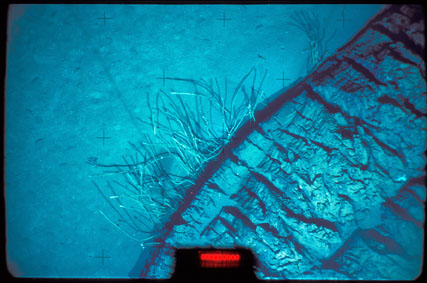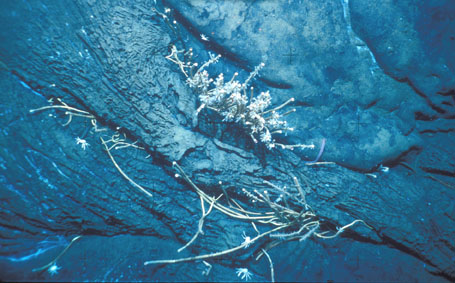
New kind of volcano discovered in the Gulf of Mexico
Underwater volcanoes that spew asphalt instead of lava: they were discovered in the Gulf of Mexico during an expedition of the research vessel Sonne, led by Prof. Gerhard Bohrmann of the DFG Research Center Ocean Margins. On these volcanoes the multinational team of scientists encountered a previously unknown highly diverse ecosystem at a water depth of 3,000 meters. The prominent scientific journal Science reports the spectacular discovery in its issue of 14 May 2004.
Asphalt, commonly known to us as the material that covers our streets, has been found flowing out of mounds that rise 450 to 800 meters above the desert-like floor of the Gulf of Mexico. Researchers discovered the asphalt volcanoes during a cruise of the research vessel Sonne. First observed in video footage, the structures were confirmed by bottom samples taken during the expedition. "We were actually only searching for the presence of methane at the seafloor, instead we found a new kind of volcano associated with a complex ecosystem," relates Prof. Gerhard Bohrmann enthusiastically.
The researchers surmise that such asphalt volcanoes only occur in the Gulf of Mexico, but that they are abundant there, because the conditions required for their formation - deep water, salt diapirs below the seafloor, and the presence of oil deposits - are found only here.
When special microorganisms deep below the seafloor degrade petroleum, asphalt remains as a waste product. It is not unusual to find small amounts of this, but in some places in the Gulf of Mexico the asphalt covers more than a square kilometer of sea bottom. The researchers christened one of the mounds "Chapopote", after the Aztec word for asphalt. Video recordings of this mound clearly show how the asphalt flowed out of the crater and down the slope. The pictures are amazingly reminiscent of lava from volcanoes on land. In addition, they are home to numerous life forms: tube worms, clams, fish, crabs, and - typical for deep-sea oases - abundant bacteria.

The geologist of the DFG Research Center Ocean Margins is fascinated. "As a scientist, one rarely has the opportunity to discover things that are still completely unknown. The chance for discoveries of this magnitude exists only in the deep sea."



Reader Comments
to our Newsletter